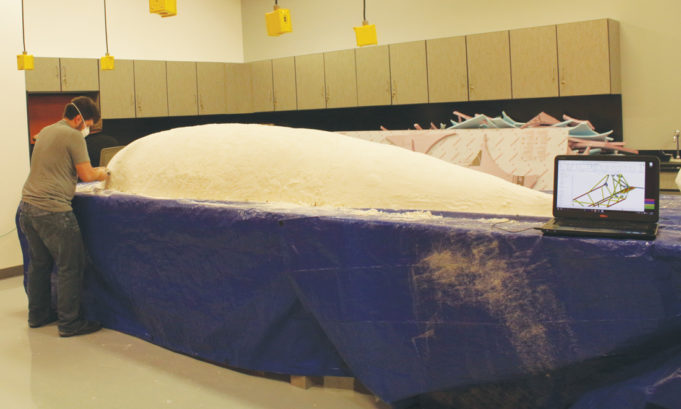Every April since 2006, students from all over North and South America flock to Detroit, Mich., with a shared purpose: to change the future of the automotive industry by competing in the Shell Eco-marathon Americas.
The contest is the North American branch of three design/racing competitions held annually all over the globe, including Shell Eco-marathons Asia and Europe. To compete, college and high school students build super-mileage vehicles and race to see who can travel farthest using the least energy. To fuel their machines, teams can use either gasoline or an alternative resource, such as hydrogen fuel or battery power. This year’s Eco-marathon will include teams from the University of North Texas and the University of Texas at Dallas, whose 2015 team took third place in the Nitrogen-Enriched Gasoline Urban Concept division.
This is UNT’s first year to compete. The six engineering students who make up the school’s team chose the Eco-marathon as their final senior project, saying it seemed both entertaining and achievable despite the tight deadline. Winners receive a $2,000 cash prize, though exposure and networking opportunities are also obvious benefits. UNT team members estimate that they are putting in about 20 hours a week on their project, all while maintaining jobs and full course loads.
“I have a test in, like, 30 minutes,” said UNT team member and driver Devin Skelton.
The students have become quite at home in this workshop, with computers, foam, tools, and building materials on every surface. The team started conceptualizing the car last year but did not start building it until February. Complications involving parts pushed the project behind schedule. Skelton admitted procrastination might also have come into play.
The Eco-marathon is divided into several categories, including “prototype gas-powered,” in which teams are permitted to be more creative with their cars’ designs and internal structures. This is the category into which the UNT team will enter its car, whose body is made from layers of stacked foam, followed by Plaster of Paris and finally fiberglass filled with carbon fiber.
“We try to keep three people working on the frame and three people working on the body,” said Matthew Carroll, a team member who adds plaster and sands the frame. He said the body is about a quarter of the way finished.
Teams must complete seven laps for a total of 6.3 miles with a minimum average speed of 15 mph. The time requirement for the prototype gas-powered category is 25 minutes, but Carroll hopes to exceed that minimum, saying he’d be happy as long as the team places. As of March 15, there are 45 other gas-powered competitors this year. That number is expected to rise.
While the prototype category does allow for creativity, vehicles must not exceed 300 centimeters (9.8 feet) in length. The UNT car pushes the limit at 285 centimeters, which poses a problem for the team.
“It doesn’t fit through the doors,” said Carroll.
Initially, the plan to make a long structure sounded good, he said, as it allowed the team to create the ideal drag-reducing vehicle: The car is tear-shaped with a gradual aerodynamic slope.
“We’re like, ‘Oh, yeah. Eleven feet. That’s no big deal,’ ” Skelton said. “But 11 feet is pretty huge when you think about it.”
Another complication is the engine placement. The driver must start the engine and, after reaching its highest speed, coast to increase speed. But the team must figure out how to start the vehicle, since the kick-start engine (similar to that of a motorcycle) will be positioned behind the driver’s head.
“Part of this is going to be driver technique,” Carroll said.
The team’s biggest design obstacle, Skelton said, was weight. Making the car lighter, is huge, as it enables the vehicle to travel farther on less fuel.
“That’s why we’re going with carbon fiber for the body, because it’s lightweight,” he said.
Kyle Horne, assistant professor of mechanical and chemical engineering at UNT, serves as the project’s faculty adviser. He said part of what makes the Eco-marathon a good fit for UNT is that it reflects the school’s environmentally conscious philosophy.
Staying green plays into the mechanical engineering program as well. Students are introduced to the concepts of energy management and conservation early on in the program, which Horne said could give them a competitive edge.
“If they do have an edge, it probably is the treatment of energy and the holistic treatment given by the program,” he said.
Though there are subcategories for cleaner-energy vehicles, Carroll and Skelton said they chose a gasoline engine because it was both easier to construct and more cost effective.
“Hydrogen fuel cell stuff is very expensive, so we didn’t want to try to bring that budget to the university,” Carroll said.
Funding for the project comes from a financial pool within the Mechanical and Chemical Engineering Department. Horne said the budgeting works differently each year, but that this was one of the more expensive ones. The cost is offset by the fact that many materials for projects are donated by outside companies. Carroll estimated the finished vehicle will cost around $8,000 –– $6,000 of that in the form of donated carbon fiber.
With public awareness of climate change fueling a shift in the automotive industry toward eco-friendly cars, Skelton and Carroll agreed that super-mileage technology could benefit both drivers and automakers.
“Obviously, this is over the top –– you can’t drive this to work –– but the principles of this can be applied elsewhere in some way,” Skelton said.
The United States, Horne said, must embrace this technology to reduce greenhouse gas emissions in the future.
“We’re going to have to create a replacement for the car,” he said, “These kinds of technologies are the building blocks from which that final solution will come.”
Skelton has enjoyed the experience but still gets nervous thinking about the race.
“I get home and have anxiety attacks,” he said. “I freak out.”
Last year’s winners were from the University of Toronto. Their vehicle reached 3,421 miles per gallon.
The UNT guys don’t expect to achieve such a high score, but they’re crossing their fingers.
“If we hit 1,000 miles, we’d be in the top five,” Carroll said.
Even if they win, Skelton said school responsibilities would take priority over celebrations at the bar. He and his fellow engineers still have finals to study for.












